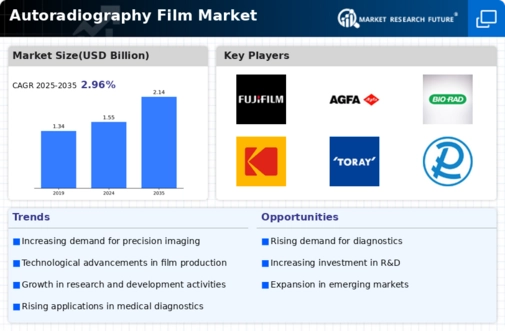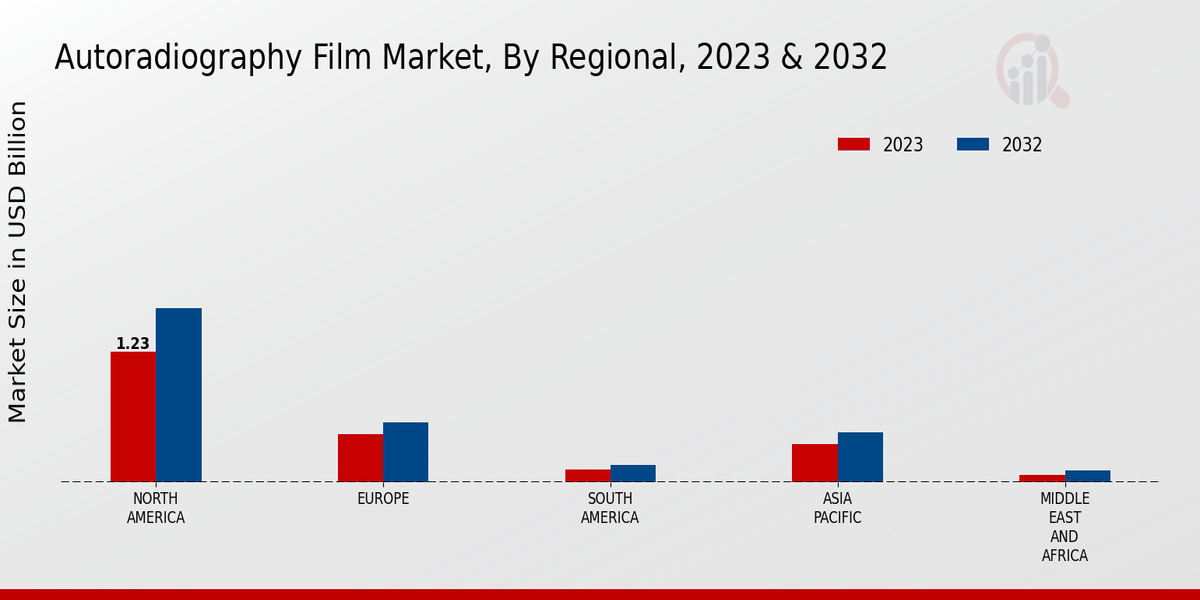Technological advancements are driving the evolution of autoradiography film market. The advent of digital autoradiography has enhanced image quality, reduced exposure times, and automated analysis, making it a more efficient and precise method for studying molecular interactions and localizing radiolabeled probes.
The increasing adoption of high-resolution autoradiography techniques, such as quantitative autoradiography and in situ hybridization, is fueling the demand for specialized autoradiography films. Furthermore, the growing applications of autoradiography in fields such as drug discovery, neuroscience, and cancer research are creating significant growth opportunities for the market.
Autoradiography Film Market Drivers
Rising Demand for Precision and Accuracy in Life Science Research
Autoradiography films play a crucial role in life science research, particularly in molecular biology and drug discovery. The increasing demand for precision and accuracy in these fields is driving the growth of the Autoradiography Film Market. Autoradiography films allow researchers to visualize and quantify the distribution of radioactive molecules within biological samples, providing valuable insights into cellular processes, gene expression, and protein-protein interactions.
The growing emphasis on personalized medicine and targeted therapies further fuels the need for precise and reliable detection methods, contributing to the increasing adoption of autoradiography films in research laboratories worldwide.
Advancements in Imaging Technologies
Technological advancements in imaging techniques are significantly impacting the Autoradiography Film Market. The development of high-resolution autoradiography films and digital imaging systems has enhanced the sensitivity and specificity of autoradiography, enabling researchers to obtain clearer and more detailed images. These advancements have opened up new possibilities for studying complex biological processes and disease mechanisms, driving the demand for autoradiography films in both academic and commercial research settings.
Growing Applications in Medical Diagnostics
Beyond life science research, autoradiography films are also gaining traction in medical diagnostics. The ability to visualize the distribution of radioactive tracers in vivo has led to the development of novel imaging techniques for disease diagnosis and treatment monitoring. For instance, autoradiography is used in nuclear medicine to assess tumor activity, evaluate organ function, and guide radiation therapy. As the demand for personalized and minimally invasive diagnostic procedures increases, the applications of autoradiography films in medical diagnostics are expected to expand, further contributing to the growth of the Autoradiography Film Market.
Autoradiography Film Market Segment Insights
Autoradiography Film Market Product Type Insights
The Autoradiography Film Market is segmented by Product Type into Standard Autoradiography Film, High-Resolution Autoradiography Film, and Fluorescent Autoradiography Film. Standard Autoradiography Film is widely used in research laboratories and hospitals for routine applications such as DNA sequencing, protein expression analysis, and cell proliferation studies. The global market for Standard Autoradiography Film is expected to reach $850 million by 2024.
High-Resolution Autoradiography Film offers higher resolution imaging compared to Standard Autoradiography Film, making it suitable for applications requiring detailed imaging, such as microscopy and histology. The market for High-Resolution Autoradiography Film is estimated to reach $450 million by 2024. Fluorescent Autoradiography Film emits light when exposed to radiation, allowing for real-time imaging.
This type of film is gaining popularity in applications such as in vivo imaging and drug discovery. The global market for Fluorescent Autoradiography Film is projected to reach $200 million by 2024. The increasing demand for high-resolution imaging in research and clinical settings is driving the growth of the Autoradiography Film market. The development of new applications, such as in vivo imaging and drug discovery, is further contributing to the market growth.
Autoradiography Film Market Application Insights
The Autoradiography Film Market is segmented on the basis of application into Life Sciences, Medical Imaging, Environmental Monitoring, and Forensics. Among these segments, Life Sciences accounted for the largest market share in 2023 and is projected to continue its dominance throughout the forecast period. The growth of this segment can be attributed to the increasing use of autoradiography film in drug discovery and development, proteomics, and genomics research.
Medical Imaging is another significant segment of the Autoradiography Film Market, owing to the rising demand for diagnostic imaging procedures such as X-rays, computed tomography (CT) scans, and magnetic resonance imaging (MRI). Environmental Monitoring and Forensics are emerging segments of the market, driven by the growing need for environmental monitoring and forensic investigations. The Autoradiography Film Market is expected to witness steady growth in the coming years, with increasing demand from various end-use industries.
Autoradiography Film Market Format Insights
The Autoradiography Film Market is segmented by Format into Roll Film, Sheet Film, and Cassettes. The Cassettes segment is expected to grow at a CAGR of 2.96% during the forecast period. The growth of the Autoradiography Film Market is attributed to the increasing demand for autoradiography techniques in various applications, such as life sciences, medical imaging, and industrial research. The market is also driven by the rising adoption of digital autoradiography systems, which offer advantages such as improved image quality, faster processing times, and reduced costs.
Key players in the Autoradiography Film Market include Fujifilm, PerkinElmer, GE Healthcare, Agfa-Gevaert, and Carestream Health.
Autoradiography Film Market Target Molecules Insights
The Autoradiography Film Market segmentation by Target Molecules includes Radioisotopes, Fluorescent Molecules, and Chemiluminescent Molecules. Radioisotopes held the largest market share in 2023, and it is expected to continue its dominance during the forecast period. The growth of this segment is attributed to the increasing demand for radioisotopes in medical imaging and research applications.
Fluorescent molecules are expected to witness the highest CAGR during the forecast period. The growth of this segment can be attributed to the increasing adoption of fluorescent molecules in cell biology and drug discovery research. Chemiluminescent molecules are also expected to witness a significant growth rate during the forecast period. The growth of this segment is attributed to the increasing use of chemiluminescent molecules in immunoassays and other diagnostic applications.
Autoradiography Film Market Sensitivity Insights
The Autoradiography Film Market segmentation by Sensitivity is categorized into Low Sensitivity, Medium Sensitivity, High Sensitivity, and Very High Sensitivity. Among these segments, in 2023, Very High Sensitivity segment held the largest share of the market in terms of revenue, and this trend is expected to continue during the forecast period (2024-2032). The growth of this segment can be attributed to the increasing demand for high-resolution images in various applications.
The High Sensitivity segment is expected to witness the highest growth rate during the forecast period. The growth of this segment can be attributed to the increasing demand for autoradiography films in medical and biological research applications. The Low Sensitivity and Medium Sensitivity segments are expected to grow at a moderate pace during the forecast period. The growth of these segments can be attributed to the increasing demand for autoradiography films in industrial and academic research applications.
In 2024, the Autoradiography Film Market for Low Sensitivity segment is projected to be valued at $260 million, while the Medium Sensitivity segment is expected to reach $320 million. The High Sensitivity segment is forecast to be valued at $440 million, and the Very High Sensitivity segment is projected to reach $560 million.
Autoradiography Film Market Regional Insights
The Autoradiography Film Market is segmented into North America, Europe, APAC, South America, and MEA. North America was the largest regional segment, accounting for over 35% of the global market share in 2023. The growth of the North American market is attributed to the increasing demand for autoradiography films in the healthcare sector, particularly in the field of oncology.
The European market is expected to witness a steady growth rate during the forecast period, owing to the rising awareness of autoradiography film applications in life science research and drug discovery. The APAC region is projected to be the fastest-growing regional segment, driven by the increasing adoption of autoradiography films in the biotechnology and pharmaceutical industries in countries such as China and India. The South American and MEA markets are expected to experience moderate growth over the next ten years.
Autoradiography Film Market Key Players and Competitive Insights
Major players in the Autoradiography Film Market are constantly striving to develop innovative products and technologies to gain a competitive edge. Leading Autoradiography Film Market players are investing heavily in research and development to expand their product portfolios and cater to the evolving needs of customers. The Autoradiography Film Market development of new products and technologies is expected to fuel the growth of the market in the coming years.
Competitive Landscape in the Autoradiography Film Market is characterized by the presence of a few major players and several smaller players. The key players in the market are constantly competing to increase their market share and gain a competitive edge. Carestream Health is a leading provider of medical imaging and healthcare IT solutions. The company offers a wide range of autoradiography films, including the Kodak BioMax MR Film, the Kodak BioMax XAR Film, and the Kodak BioMax MS Film. Carestream Health's autoradiography films are used in a variety of applications, including medical research, drug discovery, and industrial testing.
Fujifilm is another major player in the autoradiography film market. The company offers a wide range of autoradiography films, including the Fujifilm BAS-IP TR Film, the Fujifilm BAS-IP SR Film, and the Fujifilm BAS-IP MP Film. Fujifilm's autoradiography films are used in a variety of applications, including medical research, drug discovery, and industrial testing.
Key Companies in the Autoradiography Film Market Include:
FUJIFILM
GE Healthcare
Agfa
Azurfilm
Carestream Health
Promega Corporation
BioRad Laboratories
Kodak
Toray Industries
Fujifilm
Rigaku
PerkinElmer
S.T.
Konica
Autoradiography Film Market Developments
The ongoing advancements in imaging technologies and the increasing demand for precise diagnostic tools are likely to drive the growth of the autoradiography film market in the coming years.
U.S. Department of Health and Human Services










